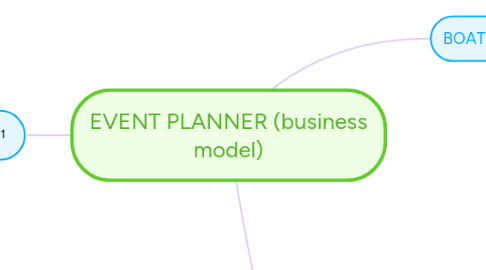
1. Overview
1.1. COST STRUCTURE
1.1.1. PHYSICAL
1.1.1.1. System architecture/design
1.1.1.2. Application design
1.1.2. Financial/ Salaries
1.1.2.1. Experts/Developers
1.1.2.2. Permanent Staff
1.1.2.3. Short term financial obligations
1.1.2.3.1. Legal advisor
1.1.2.3.2. Testers
1.1.3. FINANCIAL OBLIGATIONS ON PUBLICITY
1.1.3.1. Marketing
1.2. KEY ACTIVITIES
1.2.1. PRODUCTION/SERVICES
1.2.1.1. realtime events
1.2.1.2. annoucement/notification
1.2.1.3. benefit organisers/ participants
1.2.2. PLATFORM/NETWORK
1.2.2.1. Web portal/ Websites
1.2.2.2. Advertisement/Files
1.2.2.3. Social Media
1.2.2.4. Emails
1.3. CUSTOMER SEGEMENTS
1.3.1. PROSPECTIVE CUSTOMERS
1.3.1.1. Education/Training
1.3.1.2. Corporate institutions
1.3.1.3. Social events
1.3.1.4. People with different interests
1.3.1.4.1. Meeting other people
1.3.1.4.2. Family events
1.3.1.4.3. Group events
1.4. KEY PARTNERS
1.4.1. PARTNERS
1.4.1.1. General Corporate institutions
1.4.1.2. Event companies
1.4.1.3. Educational related orhanisations
1.4.1.4. Non- Government Organisations
1.4.1.5. Individuals
1.4.2. ACTIVITIES OF PARTNERS
1.4.2.1. Offer Services
1.4.2.2. Patronise serivises/products
1.5. CHANNELS
1.5.1. AWARENESS
1.5.1.1. Socialmedia
1.5.1.2. Marketing
1.5.1.3. Adverts
1.5.1.4. Presentations
1.5.1.5. Flyers
1.5.1.6. Official invitation/notification
1.5.2. DELIVERY/EVALUATION
1.5.2.1. Web Portal
1.5.2.2. Feedback mechanism
1.5.2.3. Customer support
1.6. CUSTOMER RELATIONSHIPS
1.6.1. CUSTOMER EXPECTATIONS
1.6.1.1. Secured
1.6.1.2. Privacy
1.6.1.3. Reliable Services
1.6.2. PERSONAL ASSISTANT/ AUTOMATION
1.6.2.1. User controlled personal assistant
1.6.2.2. Business Processes
1.7. REVENUE STREAMS
1.7.1. Subscriptions
1.7.1.1. Event
1.7.1.2. Organiser
1.7.1.3. Institutions
1.7.1.4. Organisation
1.7.2. ADVERTISMENT
1.7.2.1. Publicity
1.7.2.2. Clients
1.7.3. PROFESSIONAL DEVELOMPENT
1.7.3.1. Managers
1.7.3.2. Business Partners
1.8. VALUE PROPOSITIONS
1.8.1. NEWNESS
1.8.1.1. organisers and participants
1.8.2. Service Offering
1.8.2.1. organising and advertisning
1.8.2.2. easy access
1.8.2.3. real time sharing
1.8.3. Getting Work done
1.8.3.1. Marketing
1.8.3.2. Networking
1.8.3.3. PR
1.8.3.4. Social Communication
1.9. KEY RESOURCES
1.9.1. PHYSICAL/MATERIAL
1.9.1.1. Finance
1.9.1.2. Application and Hardware
1.9.1.3. Related/relevant peripherals
1.9.2. HUMAN
1.9.2.1. Technical Team
1.9.2.1.1. Web Developers
1.9.2.1.2. Technical Engineers
1.9.2.2. Customer
1.9.2.3. Testers (initial activities)
1.9.2.4. Legal team
2. BOAT as backdrop of business design:
2.1. BUSINESS
2.1.1. B2C- Create, publish, share event, register for event
2.1.2. B2B- Ads, Payment (PAyPal)
2.1.3. B2G- Government and Instituitions
2.2. Organisations
2.2.1. Board of Directors
2.2.1.1. Managers
2.2.1.1.1. Techical
2.2.1.1.2. Quality Assurance
2.2.1.1.3. Corporate/Public Affairs
2.2.1.1.4. Finance/Logistics
2.3. Architecture
2.3.1. Cloud Based (Saas Software as Service)
2.3.2. Three-tier architecture (View, Logic, Datasets)
2.3.3. Web Service (SOAP, Restuful)
2.3.4. Based on MCV design pattern
2.4. Technology
2.4.1. Web Server
2.4.1.1. Apache
2.4.1.2. RDBMS
2.4.1.2.1. MySQL
2.4.1.3. User interface design
2.4.1.3.1. HTML, CSS I CSS framework e.g. Bootstrap, Foundation
2.4.1.4. System behaviour
2.4.1.4.1. JavaScript I Js framework e.g. jQuery, Angular Js
2.4.1.5. Business Logic
2.4.1.5.1. PHP
2.4.1.6. Web Services
2.4.1.6.1. SOAP
2.4.1.6.2. Restful
2.4.1.6.3. UDDI
3. BUSINESS AUTOMATION PROCESSES
3.1. Hand Drawings
3.2. Signavio BPMN
3.3. YAWL
3.3.1. Control flow
3.3.2. Data flow
3.3.3. Resourcing
